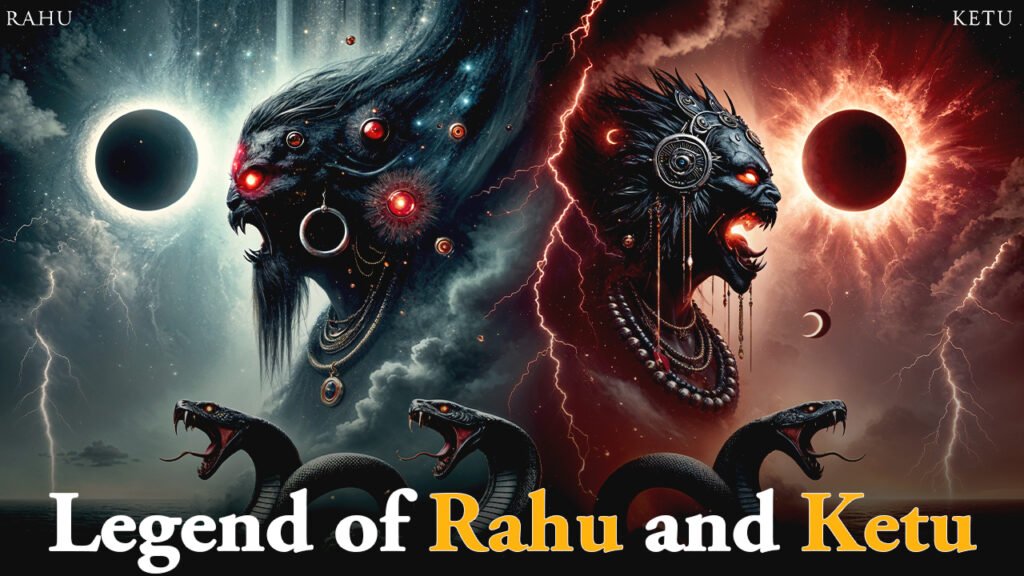Introduction to legend of Rahu and Ketu
In the rich tapestry of Hindu mythology, few tales are as captivating as the legend of Rahu and Ketu. These celestial entities, often referred to as the shadow planets or nodes of the moon, play a crucial role in both mythology and astrology. But who are Rahu and Ketu, and why do they hold such significance in Hindu culture?
Read Also: Monthly Numerology Predictions For March 2025
Origins of the Legend
The Churning of the Ocean
Our story begins with the famous episode of the churning of the cosmic ocean, known as Samudra Manthan. Picture this: the gods (Devas) and demons (Asuras) joining forces to churn the primordial ocean in search of the elixir of immortality, Amrita. It’s like a cosmic tug-of-war, with Mount Mandara as the churning rod and the serpent Vasuki as the rope. Can you imagine the scene?
Vishnu’s Intervention
As the churning progressed, various treasures emerged from the ocean. But the moment of truth came when the pot of Amrita appeared. Knowing the demons couldn’t be trusted with immortality, Lord Vishnu intervened. He took the form of Mohini, a beautiful enchantress, to distract the demons and distribute the Amrita among the gods.
Rahu’s Deception
Disguise as a Deva
Enter Svarbhanu, a clever demon with an insatiable desire for immortality. Seeing through Vishnu’s plan, he hatched a scheme of his own. Svarbhanu disguised himself as a Deva and sneakily joined the line of gods waiting to receive the Amrita. Talk about gate-crashing a cosmic party!
Drinking the Amrita
As Mohini began distributing the nectar, Svarbhanu’s plan seemed to be working. He managed to take a sip of the precious Amrita. But just as the nectar touched his throat, the Sun and Moon gods recognized the imposter and alerted Vishnu.
The Consequences
Vishnu’s Discus
Swift as lightning, Vishnu hurled his discus, the Sudarshana Chakra, at Svarbhanu. The weapon sliced through the demon’s neck, separating his head from his body. But here’s the twist – since Svarbhanu had already tasted the Amrita, he couldn’t die. Instead, his severed parts took on a life of their own.
The Birth of Rahu and Ketu
And thus, Rahu and Ketu were born. Rahu became the immortal head, while Ketu became the immortal tail and body. Imagine that – two entities, once one, now forever separated but eternally linked. It’s like a cosmic divorce with no possibility of reconciliation!
For interesting astrology-related videos, subscribe to us on YouTube
Rahu and Ketu in Hindu Astrology
Rahu’s Influence
In Hindu astrology, Rahu is associated with materialism, obsession, and worldly desires. Rahu’s influence can bring sudden changes, unexpected events, and a hunger for success.
Ketu’s Influence
Ketu, on the other hand, represents spirituality, enlightenment, and detachment from worldly affairs. If Rahu is that friend who drags you to parties, Ketu is the one who invites you to meditation retreats. Ketu’s energy is said to bring wisdom, but also confusion and unexpected obstacles.
Symbolism and Meaning
Rahu as Desire
Rahu symbolizes our insatiable desires and ambitions. It’s the part of us that’s never satisfied, always wanting more. Think of it as the cosmic equivalent of that last potato chip in the bag – you know you shouldn’t, but you just can’t resist!
Ketu as Spirituality
Ketu represents our spiritual side, the part of us that seeks liberation from the cycle of birth and death. It’s like the gentle nudge that reminds you there’s more to life than material pursuits. Ketu is that moment of clarity you get after a long meditation session.
Rahu and Ketu in Vedic Mythology
In Vedic mythology, Rahu and Ketu are often depicted as serpents or dragons. They’re believed to cause eclipses by swallowing the Sun or Moon. It’s as if the cosmos is playing a game of celestial peek-a-boo!
The Nodes in Modern Astronomy
From a scientific perspective, Rahu and Ketu correspond to the north and south nodes of the Moon – the points where the Moon’s orbit intersects the ecliptic. While not physical bodies, these nodes play a crucial role in predicting eclipses. It’s fascinating how ancient wisdom and modern science sometimes align, isn’t it?
Cultural Impact
In Literature
The legend of Rahu and Ketu has inspired countless stories, poems, and plays in Indian literature. From ancient Sanskrit texts to modern novels, these celestial dragons continue to capture the imagination of writers and readers alike.
In Art
In visual arts, Rahu and Ketu are often depicted as serpentine creatures or disembodied heads. Their images adorn temple walls, manuscripts, and even modern graphic novels. It’s a testament to their enduring presence in the cultural consciousness.
Rahu and Ketu in Other Cultures
Interestingly, similar concepts exist in other cultures. In Chinese astrology, there’s the Dragon’s Head and Dragon’s Tail. In Western astrology, we have the North Node and South Node. It seems the idea of celestial dragons is a cross-cultural phenomenon!
Astrological Remedies
For those who believe in astrology, there are various remedies to appease Rahu and Ketu. These range from wearing specific gemstones to chanting mantras. Whether you’re a believer or a skeptic, you’ve got to admire the intricate system of beliefs that has developed around these entities.
Scientific Perspective
From a scientific standpoint, Rahu and Ketu are mathematical points rather than physical bodies. They play a crucial role in eclipse calculations. It’s a beautiful example of how mythology and science can offer different lenses to view the same phenomena.
Conclusion of legend of Rahu and Ketu
The legend of Rahu and Ketu is more than just a mythological tale. It’s a story that continues to resonate with people, offering insights into human nature, desire, and the quest for spiritual growth. Whether you see them as mythical beings, astrological influences, or astronomical points, Rahu and Ketu remind us of the complex interplay between the celestial and the earthly in human culture.
Read Also: Gemini Moon: Traits Characteristics and Compatibility
FAQs
- Are Rahu and Ketu visible in the sky?No, Rahu and Ketu are not visible celestial bodies. They represent mathematical points in the Moon’s orbit.
- How often do Rahu and Ketu change signs in astrology?In Vedic astrology, Rahu and Ketu change signs approximately every 18 months.
- Can Rahu and Ketu have positive effects in astrology?Yes, while often associated with challenges, Rahu and Ketu can also bring positive transformations and spiritual growth when well-placed in a birth chart.
- Is the concept of Rahu and Ketu unique to Hindu mythology?While the specific legend is unique to Hindu mythology, similar concepts of celestial nodes exist in other cultures and astrological systems.
- How do modern astronomers view Rahu and Ketu?Modern astronomers recognize Rahu and Ketu as the north and south nodes of the Moon, important points for calculating eclipses, but not as physical entities.

